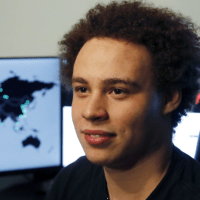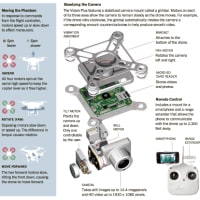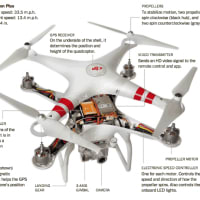Betting On Food Prices May Sell The Hungry Short
食料投機は飢饉を空売りしているようなもの
(飢饉を見越して売り、飢饉になったら儲ける)
by Marilyn Geewax
October 16, 2011
このような規制強化の動きは大歓迎だ、グローバルな観点で、こういう仕組みを変えていくことが大事だ。
 Scott Olson/Getty Images
Scott Olson/Getty Images
For speculators, food is a commodity to trade, not eat.
October 16, 2011
Speculators in the agricultural commodities markets are forcing grocery prices to rise too quickly and erratically, according to some top economists marking World Food Day on Sunday.
農産物市場における投機が食料価格を急上昇させ、不安定にしていると、日曜日の世界食糧デーにおいて、トップエコノミスト達が指摘した。
"Excessive financial speculation is contributing to increasing volatility and record food prices, exacerbating global hunger and poverty," wrote 461 economists, from more than 40 countries, in an open letter.しょ
「過剰な資金投機が食料価格を急騰させ、記録的な価格にすることで、世界の飢饉や貧困を悪化させている。」と40か国からの461人のエコノミストが公開状で表明した。
They called upon the U.S. Commodity Futures Trading Commission to crack down on speculators who have been buying large amounts of corn, wheat, soy and other commodities, hoping to make a profit. The economists argue that increased trading is a significant part of the reason grocery prices are higher this year.
彼らは米国商品先物取引委員会に、利益追求目的で、トウモロコシ、小麦、豆、その他の農産物を大量に買い占める投機家を取り締まるように申し入れた。 エコノミスト達は、今年の食料品類の価格高騰は、その大部分が、この行き過ぎた取引の増加によるものだと指摘している。
And grocery prices are indeed up this year. For example, in August, the average price of bread in U.S. cities was up 17.4 percent over last year, while milk was up 12.4 percent, according to the latest report from the Bureau of Labor Statistics.
食料品価格は今年実際に上昇している。 例えば、労働統計局の最近の報告によると、8月にバンの米国内の平均価格は昨年に比して17.4%も上昇しており、ミルクは12.4%上昇している。
Brandon Kliethermes, an agriculture economist with the forecasting firm IHS Global Insight, agrees that speculators do increase volatility — exaggerating price moves up and down.
"These markets have been bouncing around quite a bit for the past year now," Kliethermes said.
But not everyone agrees price speculation is the root of the problem. Economists have yet to find clear evidence that financial speculation can change food prices over time. Searching data for any meaningful price manipulation is very hard to quantify, Kliethermes said.
"You can't really point a finger at speculators," he said.
予測会社IHSグローバル・インサイトの農業エコノミストである、ブランドン・クライサーメス氏は、投機家が極端に価格を上げ下げすることで、価格の不安定さを増していると認めている。 「これらの市場はこの一年非常に荒い動きをしてきた。」と同氏は語る。 しかし、全ての人が、この問題の根っこに資金投機があると考えているわけではない。 エコノミストは、投機が食料価格をひとりでに変えることができるという明確な証拠はまだない。 価格操作を示す意味のあるボリュームのデータを求めるのは非常に困難だと彼は認めている。 「投機家の責任だと明確に証拠を持って明示することは出来ないのです。」
The Commodity Futures Trading Commission is expected to soon issue new rules about commodity speculation, as required under the Dodd-Frank Wall Street Reform and Consumer Protection Act.
商品先物取引委員会は、金融取規制改革法(ドッド・フランク・ウォール街改革及び消費者保護条例)の要請に基づき、近く商品投機についての新しい規制を出すとみられる。
And next month in France, the subject will be in the spotlight at a summit involving top leaders of the G20 — a group of the world's biggest economies. The host, French president Nicolas Sarkozy is pushing for tighter controls to stop speculators from betting on crop prices.
そして来月のフランスにおいて、世界の主要経済大国の集まりであるG20の各国指導者を交えてのサミットで中心議題となる見込みである。 ホスト国であるフランスの大統領ニコラス・サルコジは、食料価格に資金を注ぎ込む投機家への厳しい規制を積極的に推進している。
The issue centers on whether commodity exchanges are now hurting food prices when, in theory, they should be helping hold down grocery prices. Here's how it's supposed to work:
Say a company needs corn to make corn flakes. It could go to a commodities exchange and agree to buy corn at a particular price, spelled out in a contract. Having a known price would allow the cereal maker to go forward with plans to produce and sell corn flakes.
この問題は、理論的に、食料品価格を下げるのを助けるべきときに、商品取引が価格を(吊り上げて)市場を損なっていないかどうかに重点が置かれる。 ここに、いかにして価格が決められるかの例がある。 例えば、ここにコーンフレークを製造する会社があるとしよう。 この会社は商品取引所に出向いてトウモロコシを、契約に規定された、ある特定の価格で購入します。 この原料価格を知ることで、シリアルメーカーは生産計画を進めることができ、コーンフレークを売ることが出来るようになるのです。
The company might get a lower price if it waits longer to buy corn, so locking in a price involves some risk. But on balance, the deal makes good business sense: the cereal maker gets certainty about the price of corn, and the farmer gets certainty about the price he'll get for his crop. And consumers win because such transactions smooth out risks. That reduction in risk encourages people to become farmers and companies to make corn flakes — everyone wins.
会社は、トウモロコシの購入を先延ばしにすれば、価格が安くなるかもしれないので、価格を固定するのには、ある程度リスクを見込まねばなりません。 しかし、バランスをとることで、取引は良好なビジネスセンスを生みだします。つまり、シリアルメーカーはトウモロコシ価格である程度利益を出し、同様に農家も彼の作物からある程度の利益を出します。そして消費者は、そのようなスムーズな取引行為の結果、リスクを少なくすることが出来るのです。 リスク負担の軽減は消費者を農家を応援し、メーカーがコーンフレークを作るのも応援します。 ・・・そうすることで誰もが利益に浴することが出来るのです。
But speculators have been pouring into the commodities market, hoping to make more money there than in the stock market. A UN report shows that money invested in food commodities shot from $13 billion in 2003 to $260 billion just five years later.
These financial speculators buy and sell contracts, but never grow corn or make corn flakes, according to Alan Bjerga, author of a just-released book, Endless Appetites — How the Commodities Casino Creates Hunger and Unrest.
しかし、投機家が、株式市場よりも、より多くの利益を期待して、商品取引市場に資金を注ぎ込んできました。 国連の報告では食料品取引に2003年は130億ドルの資金が投資されていたのが、この5年間で2600億ドルに跳ね上がっています。
出版したばかりの本、「エンドレス・アピタイト(果てしなき欲望)・・いかにして商品取引カジノは飢餓と暴動を引き起こしてきたか」の著者であるアラン・ビジャガ氏によると、これらの投機家は、決してトウモロコシを育てることも、コーンフレークも製造することもなく、ただ契約で売り買いするだけです、と述べている。
Among the speculators, "no one ever takes delivery of the grains," Bjerga said. It's just paper being passed back and forth among investors betting on price moves.
Critics say food should not be traded like gold or stocks, purely for financial gain. Their demands for change are being made on World Food Day, an annual event marking the 1945 launch of the Food and Agriculture Organization of the United Nations (FAO).
投機家達のなかでは、「誰もその食物の配送にタッチしていないのです。」と彼は言う。 それは単に、変化する価格に賭けて、書類を投資家の間でやり取りするに過ぎないのです。
評論家は食料というものは、そもそも銀やその他の株のように純粋な利益追求だけのために取引されるべき対象としてはいけないと言っている。 彼らのこの変更要求は、1945年に国連食糧農業機関の発足を記念した毎年恒例の世界食糧デーに合わせて公表された。
The U.N. agency tracks — and tries to end — hunger around the world. Many fast-developing countries, especially in Asia, have made dramatic progress in recent years. Still, hunger remains the world's No. 1 health risk, killing more people than diseases such as HIV/AIDS, malaria and tuberculosis.
FAO reports that about 925 million people do not have enough to eat, with the worst problems being concentrated in South Asia and sub-Saharan Africa.
国連当局は世界中の飢饉を調査し、それを無くそうとしている。多くの急成長国、特にアジア、は近年において劇的な進歩を遂げているが、まだ飢えは健康リスクで世界一に留まり、エイズ、マラリア、結核などの病死よりも多くの人々が飢えでなくなっている。
国連食糧農業機関は、最悪の問題は9億2500万人の人々が飢えており、とくに南アジアとアフリカのサハラ周辺地域にそれが集中しているとしている。
食料投機は飢饉を空売りしているようなもの
(飢饉を見越して売り、飢饉になったら儲ける)
by Marilyn Geewax
October 16, 2011
このような規制強化の動きは大歓迎だ、グローバルな観点で、こういう仕組みを変えていくことが大事だ。
 Scott Olson/Getty Images
Scott Olson/Getty Images For speculators, food is a commodity to trade, not eat.
October 16, 2011
Speculators in the agricultural commodities markets are forcing grocery prices to rise too quickly and erratically, according to some top economists marking World Food Day on Sunday.
農産物市場における投機が食料価格を急上昇させ、不安定にしていると、日曜日の世界食糧デーにおいて、トップエコノミスト達が指摘した。
"Excessive financial speculation is contributing to increasing volatility and record food prices, exacerbating global hunger and poverty," wrote 461 economists, from more than 40 countries, in an open letter.しょ
「過剰な資金投機が食料価格を急騰させ、記録的な価格にすることで、世界の飢饉や貧困を悪化させている。」と40か国からの461人のエコノミストが公開状で表明した。
They called upon the U.S. Commodity Futures Trading Commission to crack down on speculators who have been buying large amounts of corn, wheat, soy and other commodities, hoping to make a profit. The economists argue that increased trading is a significant part of the reason grocery prices are higher this year.
彼らは米国商品先物取引委員会に、利益追求目的で、トウモロコシ、小麦、豆、その他の農産物を大量に買い占める投機家を取り締まるように申し入れた。 エコノミスト達は、今年の食料品類の価格高騰は、その大部分が、この行き過ぎた取引の増加によるものだと指摘している。
And grocery prices are indeed up this year. For example, in August, the average price of bread in U.S. cities was up 17.4 percent over last year, while milk was up 12.4 percent, according to the latest report from the Bureau of Labor Statistics.
食料品価格は今年実際に上昇している。 例えば、労働統計局の最近の報告によると、8月にバンの米国内の平均価格は昨年に比して17.4%も上昇しており、ミルクは12.4%上昇している。
Brandon Kliethermes, an agriculture economist with the forecasting firm IHS Global Insight, agrees that speculators do increase volatility — exaggerating price moves up and down.
"These markets have been bouncing around quite a bit for the past year now," Kliethermes said.
But not everyone agrees price speculation is the root of the problem. Economists have yet to find clear evidence that financial speculation can change food prices over time. Searching data for any meaningful price manipulation is very hard to quantify, Kliethermes said.
"You can't really point a finger at speculators," he said.
予測会社IHSグローバル・インサイトの農業エコノミストである、ブランドン・クライサーメス氏は、投機家が極端に価格を上げ下げすることで、価格の不安定さを増していると認めている。 「これらの市場はこの一年非常に荒い動きをしてきた。」と同氏は語る。 しかし、全ての人が、この問題の根っこに資金投機があると考えているわけではない。 エコノミストは、投機が食料価格をひとりでに変えることができるという明確な証拠はまだない。 価格操作を示す意味のあるボリュームのデータを求めるのは非常に困難だと彼は認めている。 「投機家の責任だと明確に証拠を持って明示することは出来ないのです。」
The Commodity Futures Trading Commission is expected to soon issue new rules about commodity speculation, as required under the Dodd-Frank Wall Street Reform and Consumer Protection Act.
商品先物取引委員会は、金融取規制改革法(ドッド・フランク・ウォール街改革及び消費者保護条例)の要請に基づき、近く商品投機についての新しい規制を出すとみられる。
And next month in France, the subject will be in the spotlight at a summit involving top leaders of the G20 — a group of the world's biggest economies. The host, French president Nicolas Sarkozy is pushing for tighter controls to stop speculators from betting on crop prices.
そして来月のフランスにおいて、世界の主要経済大国の集まりであるG20の各国指導者を交えてのサミットで中心議題となる見込みである。 ホスト国であるフランスの大統領ニコラス・サルコジは、食料価格に資金を注ぎ込む投機家への厳しい規制を積極的に推進している。
The issue centers on whether commodity exchanges are now hurting food prices when, in theory, they should be helping hold down grocery prices. Here's how it's supposed to work:
Say a company needs corn to make corn flakes. It could go to a commodities exchange and agree to buy corn at a particular price, spelled out in a contract. Having a known price would allow the cereal maker to go forward with plans to produce and sell corn flakes.
この問題は、理論的に、食料品価格を下げるのを助けるべきときに、商品取引が価格を(吊り上げて)市場を損なっていないかどうかに重点が置かれる。 ここに、いかにして価格が決められるかの例がある。 例えば、ここにコーンフレークを製造する会社があるとしよう。 この会社は商品取引所に出向いてトウモロコシを、契約に規定された、ある特定の価格で購入します。 この原料価格を知ることで、シリアルメーカーは生産計画を進めることができ、コーンフレークを売ることが出来るようになるのです。
The company might get a lower price if it waits longer to buy corn, so locking in a price involves some risk. But on balance, the deal makes good business sense: the cereal maker gets certainty about the price of corn, and the farmer gets certainty about the price he'll get for his crop. And consumers win because such transactions smooth out risks. That reduction in risk encourages people to become farmers and companies to make corn flakes — everyone wins.
会社は、トウモロコシの購入を先延ばしにすれば、価格が安くなるかもしれないので、価格を固定するのには、ある程度リスクを見込まねばなりません。 しかし、バランスをとることで、取引は良好なビジネスセンスを生みだします。つまり、シリアルメーカーはトウモロコシ価格である程度利益を出し、同様に農家も彼の作物からある程度の利益を出します。そして消費者は、そのようなスムーズな取引行為の結果、リスクを少なくすることが出来るのです。 リスク負担の軽減は消費者を農家を応援し、メーカーがコーンフレークを作るのも応援します。 ・・・そうすることで誰もが利益に浴することが出来るのです。
But speculators have been pouring into the commodities market, hoping to make more money there than in the stock market. A UN report shows that money invested in food commodities shot from $13 billion in 2003 to $260 billion just five years later.
These financial speculators buy and sell contracts, but never grow corn or make corn flakes, according to Alan Bjerga, author of a just-released book, Endless Appetites — How the Commodities Casino Creates Hunger and Unrest.
しかし、投機家が、株式市場よりも、より多くの利益を期待して、商品取引市場に資金を注ぎ込んできました。 国連の報告では食料品取引に2003年は130億ドルの資金が投資されていたのが、この5年間で2600億ドルに跳ね上がっています。
出版したばかりの本、「エンドレス・アピタイト(果てしなき欲望)・・いかにして商品取引カジノは飢餓と暴動を引き起こしてきたか」の著者であるアラン・ビジャガ氏によると、これらの投機家は、決してトウモロコシを育てることも、コーンフレークも製造することもなく、ただ契約で売り買いするだけです、と述べている。
Among the speculators, "no one ever takes delivery of the grains," Bjerga said. It's just paper being passed back and forth among investors betting on price moves.
Critics say food should not be traded like gold or stocks, purely for financial gain. Their demands for change are being made on World Food Day, an annual event marking the 1945 launch of the Food and Agriculture Organization of the United Nations (FAO).
投機家達のなかでは、「誰もその食物の配送にタッチしていないのです。」と彼は言う。 それは単に、変化する価格に賭けて、書類を投資家の間でやり取りするに過ぎないのです。
評論家は食料というものは、そもそも銀やその他の株のように純粋な利益追求だけのために取引されるべき対象としてはいけないと言っている。 彼らのこの変更要求は、1945年に国連食糧農業機関の発足を記念した毎年恒例の世界食糧デーに合わせて公表された。
The U.N. agency tracks — and tries to end — hunger around the world. Many fast-developing countries, especially in Asia, have made dramatic progress in recent years. Still, hunger remains the world's No. 1 health risk, killing more people than diseases such as HIV/AIDS, malaria and tuberculosis.
FAO reports that about 925 million people do not have enough to eat, with the worst problems being concentrated in South Asia and sub-Saharan Africa.
国連当局は世界中の飢饉を調査し、それを無くそうとしている。多くの急成長国、特にアジア、は近年において劇的な進歩を遂げているが、まだ飢えは健康リスクで世界一に留まり、エイズ、マラリア、結核などの病死よりも多くの人々が飢えでなくなっている。
国連食糧農業機関は、最悪の問題は9億2500万人の人々が飢えており、とくに南アジアとアフリカのサハラ周辺地域にそれが集中しているとしている。



















